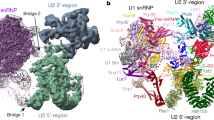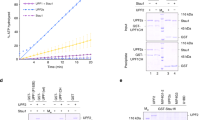Abstract
The exon junction complex (EJC), a set of proteins deposited on mRNAs as a consequence of pre-mRNA splicing, is a key effector of downstream mRNA metabolism. We have identified eIF4AIII, a member of the eukaryotic translation initiation factor 4A family of RNA helicases (also known as DExH/D box proteins), as a novel EJC core component. Crosslinking and antibody inhibition studies suggest that eIF4AIII constitutes at least part of the platform anchoring other EJC components to spliced mRNAs. A nucleocytoplasmic shuttling protein, eIF4AIII associates in vitro and in vivo with two other EJC core factors, Y14 and Magoh. In mammalian cells, eIF4AIII is essential for nonsense-mediated mRNA decay (NMD). Finally, a model is proposed by which eIF4AIII represents a new functional class of DExH/D box proteins that act as RNA clamps or 'place holders' for the sequence-independent attachment of additional factors to RNAs.
This is a preview of subscription content, access via your institution
Access options
Subscribe to this journal
Receive 12 print issues and online access
$189.00 per year
only $15.75 per issue
Buy this article
- Purchase on Springer Link
- Instant access to full article PDF
Prices may be subject to local taxes which are calculated during checkout




Similar content being viewed by others
References
Le Hir, H., Izaurralde, E., Maquat, L.E. & Moore, M.J. The spliceosome deposits multiple proteins 20–24 nucleotides upstream of mRNA exon-exon junctions. EMBO J. 19, 6860–6869 (2000).
Le Hir, H., Nott, A. & Moore, M.J. How introns influence and enhance eukaryotic gene expression. Trends Biochem. Sci. 28, 215–220 (2003).
Ishigaki, Y., Li, X., Serin, G. & Maquat, L.E. Evidence for a pioneer round of mRNA translation: mRNAs subject to nonsense-mediated decay in mammalian cells are bound by CBP80 and CBP20. Cell 106, 607–617 (2001).
Lejeune, F., Ishigaki, Y., Li, X. & Maquat, L.E. The exon junction complex is detected on CBP80-bound but not eIF4E-bound mRNA in mammalian cells: dynamics of mRNP remodeling. EMBO J. 21, 3536–3545 (2002).
Dostie, J. & Dreyfuss, G. Translation is required to remove Y14 from mRNAs in the cytoplasm. Curr. Biol. 12, 1060–1067 (2002).
Wagner, E. & Lykke-Andersen, J. mRNA surveillance: the perfect persist. J. Cell Sci. 115, 3033–3038 (2002).
Culbertson, M.R. & Leeds, P.F. Looking at mRNA decay pathways through the window of molecular evolution. Curr. Opin. Genet. Dev. 13, 207–214 (2003).
Le Hir, H., Gatfield, D., Izaurralde, E. & Moore, M.J. The exon-exon junction complex provides a binding platform for factors involved in mRNA export and nonsense-mediated mRNA decay. EMBO J. 20, 4987–4997 (2001).
Zhou, Z. et al. The protein Aly links pre-messenger-RNA splicing to nuclear export in metazoans. Nature 407, 401–405 (2000).
Nott, A., Le Hir, H. & Moore, M.J. Splicing enhances translation in mammalian cells: an additional function of the exon junction complex. Genes Dev. 18, 210–222 (2004).
Palacios, I.M. RNA processing: splicing and the cytoplasmic localisation of mRNA. Curr. Biol. 12, R50–52 (2002).
Reichert, V.L., Le Hir, H., Jurica, M.S. & Moore, M.J. 5′ exon interactions within the human spliceosome establish a framework for exon junction complex structure and assembly. Genes Dev. 16, 2778–2791 (2002).
Jurica, M.S. & Moore, M.J. Pre-mRNA splicing: awash in a sea of proteins. Mol. Cell 12, 5–14 (2003).
Kataoka, N. et al. Pre-mRNA splicing imprints mRNA in the nucleus with a novel RNA-binding protein that persists in the cytoplasm. Mol. Cell 6, 673–682 (2000).
Kataoka, N., Diem, M.D., Kim, V.N., Yong, J. & Dreyfuss, G. Magoh, a human homolog of Drosophila mago nashi protein, is a component of the splicing-dependent exon-exon junction complex. EMBO J. 20, 6424–6433 (2001).
Le Hir, H., Gatfield, D., Braun, I.C., Forler, D. & Izaurralde, E. The protein Mago provides a link between splicing and mRNA localization. EMBO Rep. 2, 1119–1124 (2001).
Kim, V.N. et al. The Y14 protein communicates to the cytoplasm the position of exon-exon junctions. EMBO J. 20, 2062–2068 (2001).
Fribourg, S., Gatfield, D., Izaurralde, E. & Conti, E. A novel mode of RBD-protein recognition in the Y14-Mago complex. Nat. Struct. Biol. 10, 433–439 (2003).
Shi, H. & Xu, R.M. Crystal structure of the Drosophila Mago nashi-Y14 complex. Genes Dev. 17, 971–976 (2003).
Lau, C.K., Diem, M.D., Dreyfuss, G. & Van Duyne, G.D. Structure of the y14-magoh core of the exon junction complex. Curr. Biol. 13, 933–941 (2003).
Jurica, M.S., Licklider, L.J., Gygi, S.R., Grigorieff, N. & Moore, M.J. Purification and characterization of native spliceosomes suitable for three-dimensional structural analysis. RNA 8, 426–439 (2002).
Li, Q. et al. Eukaryotic translation initiation factor 4AIII (eIF4AIII) is functionally distinct from eIF4AI and eIF4AII. Mol. Cell. Biol. 19, 7336–7346 (1999).
Holzmann, K. et al. A human common nuclear matrix protein homologous to eukaryotic translation initiation factor 4A. Biochem. Biophys. Res. Commun. 267, 339–344 (2000).
Weinstein, D.C., Honoré, E. & Hemmati-Brivanlou, A. Epidermal induction and inhibition of neural fate by translation initiation factor 4AIII. Development 124, 4235–4242 (1997).
Gingras, A.C., Raught, B. & Sonenberg, N. eIF4 initiation factors: effectors of mRNA recruitment to ribosomes and regulators of translation. Annu. Rev. Biochem. 68, 913–963 (1999).
Rogers, G.W., Jr., Komar, A.A. & Merrick, W.C. eIF4A: the godfather of the DEAD box helicases. Prog. Nucleic Acid Res. Mol. Biol. 72, 307–331 (2002).
Zhou, Z., Licklider, L.J., Gygi, S.P. & Reed, R. Comprehensive proteomic analysis of the human spliceosome. Nature 419, 182–185 (2002).
Le Hir, H., Moore, M.J. & Maquat, L.E. Pre-mRNA splicing alters mRNP composition: evidence for stable association of proteins at exon-exon junctions. Genes Dev. 14, 1098–1108 (2000).
Lykke-Andersen, J., Shu, M.D. & Steitz, J.A. Communication of the position of exon-exon junctions to the mRNA surveillance machinery by the protein RNPS1. Science 293, 1836–1839 (2001).
Elbashir, S.M. et al. Duplexes of 21-nucleotide RNAs mediate RNA interference in cultured mammalian cells. Nature 411, 494–498 (2001).
Mendell, J.T., ap Rhys, C.M. & Dietz, H.C. Separable roles for rent1/hUpf1 in altered splicing and decay of nonsense transcripts. Science 298, 419–422 (2002).
Zhou, Z. & Reed, R. Human homologs of yeast prp16 and prp17 reveal conservation of the mechanism for catalytic step II of pre-mRNA splicing. EMBO J. 17, 2095–2106 (1998).
Perlick, H.A., Medghalchi, S.M., Spencer, F.A., Kendzior, R.J. Jr. & Dietz, H.C. Mammalian orthologues of a yeast regulator of nonsense transcript stability. Proc. Natl. Acad. Sci. USA 93, 10928–10932 (1996).
Wilusz, C.J., Wang, W. & Peltz, S.W. Curbing the nonsense: the activation and regulation of mRNA surveillance. Genes Dev. 15, 2781–2785 (2001).
Mühlemann, O. et al. Precursor RNAs harboring nonsense codons accumulate near the site of transcription. Mol. Cell 8, 33–43 (2001).
Tanner, N.K. & Linder, P. DExD/H box RNA helicases: from generic motors to specific dissociation functions. Mol. Cell 8, 251–262 (2001).
Kim, J.L. et al. Hepatitis C virus NS3 RNA helicase domain with a bound oligonucleotide: the crystal structure provides insights into the mode of unwinding. Structure 6, 89–100 (1998).
de la Cruz, J., Kressler, D. & Linder, P. Unwinding RNA in Saccharomyces cerevisiae: DEAD-box proteins and related families. Trends Biochem. Sci. 24, 192–198 (1999).
Linder, P., Tanner, N.K. & Banroques, J. From RNA helicases to RNPases. Trends Biochem. Sci. 26, 339–341 (2001).
Schwer, B. A new twist on RNA helicases: DExH/D box proteins as RNPases. Nat. Struct. Biol. 8, 113–116 (2001).
Jankowsky, E., Gross, C.H., Shuman, S. & Pyle, A.M. Active disruption of an RNA-protein interaction by a DExH/D RNA helicase. Science 291, 121–125 (2001).
Query, C.C., Strobel, S.A. & Sharp, P.A. Three recognition events at the branch-site adenine. EMBO J. 15, 1392–1402 (1996).
Maroney, P.A., Romfo, C.M. & Nilsen, T.W. Functional recognition of 5′ splice site by U4/U6. U5 tri-snRNP defines a novel ATP-dependent step in early spliceosome assembly. Mol. Cell 6, 317–328 (2000).
Gozani, O., Feld, R. & Reed, R. Evidence that sequence-independent binding of highly conserved U2 snRNP proteins upstream of the branch site is required for assembly of spliceosomal complex A. Genes Dev. 10, 233–243 (1996).
Palacios, I.M., Gatfield, D., St Johnston, D. & Izaurralde, E. An eIF4AIII-containing complex required for mRNA localization and nonsense-mediated mRNA decay. Nature 427, 753–757 (2004).
Fan, X.C. & Steitz, J.A. Overexpression of HuR, a nuclear-cytoplasmic shuttling protein, increases the in vivo stability of ARE-containing mRNAs. EMBO J. 17, 3448–3460 (1998).
Chan, C.C. et al. eIF4A3 is a novel component of the exon junction complex. RNA 10, 200–209 (2004).
Ferraiuolo, M.A. et al. A nuclear translation-like factor eIF4AIII is recruited to the mRNA during splicing and functions in nonsense-mediated decay. Proc. Natl. Acad. Sci. USA. (in the press).
Acknowledgements
We thank E. Izaurralde, R. Reed and J. Steitz for plasmids and antibodies against Y14 and Magoh. We are grateful to G. Dreyfuss, E. Izaurralde and R. Reed for communicating results prior to publication. We acknowledge our laboratory members, especially M. Jurica, A. Nott, F. LaRiviere and C. Mock-Casagrande for helpful advice and discussions. We are grateful to N. Levin for synthesizing siRNA oligos. M.J.M. is a Howard Hughes Medical Institute associate investigator. This work was supported in part by US National Institutes of Health grant GM53007 (M.J.M.) and a research stipend from the Alfred Benzon Foundation (T.Ø.T.).
Author information
Authors and Affiliations
Corresponding author
Ethics declarations
Competing interests
The authors declare no competing financial interests.
Rights and permissions
About this article
Cite this article
Shibuya, T., Tange, T., Sonenberg, N. et al. eIF4AIII binds spliced mRNA in the exon junction complex and is essential for nonsense-mediated decay. Nat Struct Mol Biol 11, 346–351 (2004). https://doi.org/10.1038/nsmb750
Received:
Accepted:
Published:
Issue Date:
DOI: https://doi.org/10.1038/nsmb750
This article is cited by
-
The DEAD-box RNA helicase eIF4A regulates plant development and interacts with the hnRNP LIF2L1 in Physcomitrella patens
Molecular Genetics and Genomics (2020)
-
Promoter-proximal pausing mediated by the exon junction complex regulates splicing
Nature Communications (2019)
-
Exon junction complex components Y14 and Mago still play a role in budding yeast
Scientific Reports (2019)
-
Spatio-temporal expression of ANK2 promotes cytokinesis in oocytes
Scientific Reports (2019)
-
New Directions for Understanding the Codon Redefinition Required for Selenocysteine Incorporation
Biological Trace Element Research (2019)



